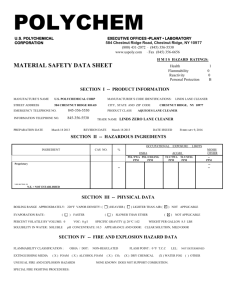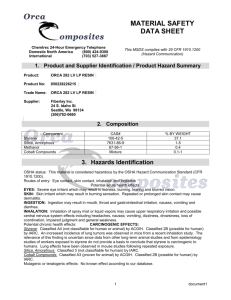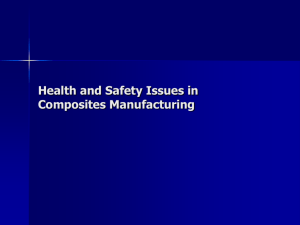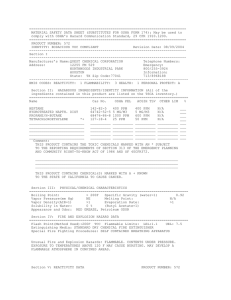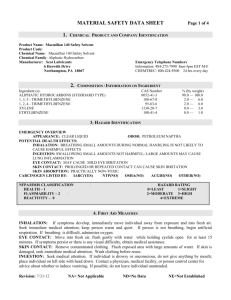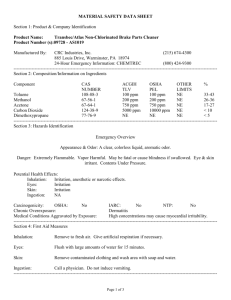Raw Material for Insulator
advertisement
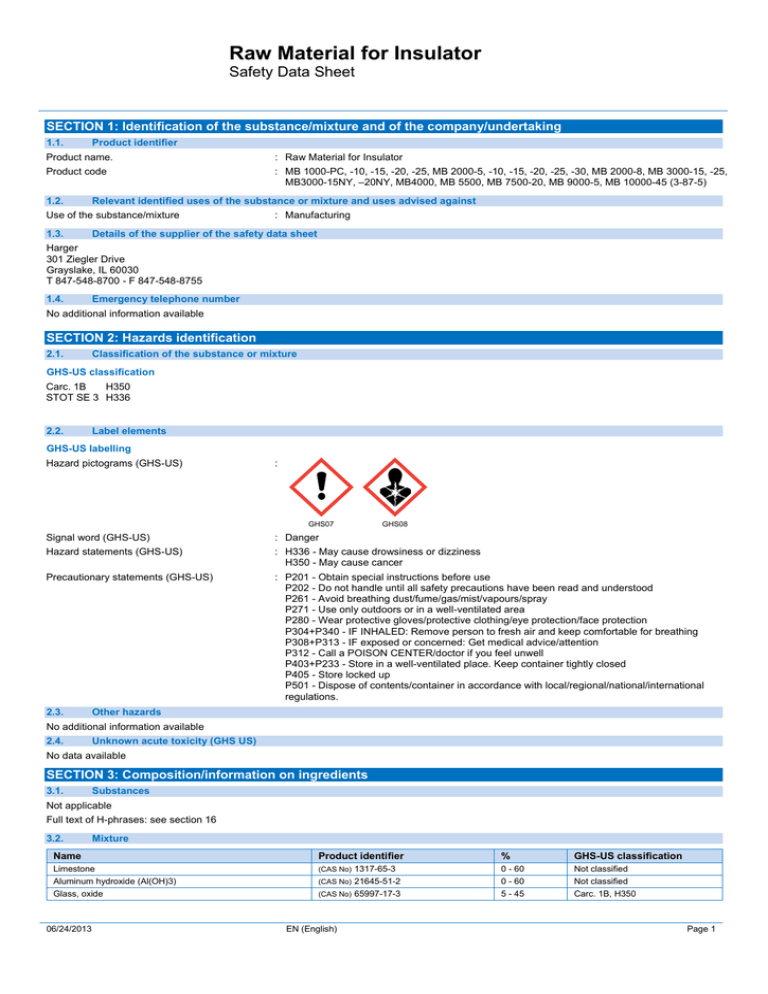
Raw Material for Insulator Safety Data Sheet SECTION 1: Identification of the substance/mixture and of the company/undertaking 1.1. Product identifier Product name. : Raw Material for Insulator Product code : MB 1000-PC, -10, -15, -20, -25, MB 2000-5, -10, -15, -20, -25, -30, MB 2000-8, MB 3000-15, -25, MB3000-15NY, –20NY, MB4000, MB 5500, MB 7500-20, MB 9000-5, MB 10000-45 (3-87-5) 1.2. Relevant identified uses of the substance or mixture and uses advised against Use of the substance/mixture 1.3. : Manufacturing Details of the supplier of the safety data sheet Harger 301 Ziegler Drive Grayslake, IL 60030 T 847-548-8700 - F 847-548-8755 1.4. Emergency telephone number No additional information available SECTION 2: Hazards identification 2.1. Classification of the substance or mixture GHS-US classification Carc. 1B H350 STOT SE 3 H336 2.2. Label elements GHS-US labelling Hazard pictograms (GHS-US) : Signal word (GHS-US) : Danger Hazard statements (GHS-US) : H336 - May cause drowsiness or dizziness H350 - May cause cancer Precautionary statements (GHS-US) : P201 - Obtain special instructions before use P202 - Do not handle until all safety precautions have been read and understood P261 - Avoid breathing dust/fume/gas/mist/vapours/spray P271 - Use only outdoors or in a well-ventilated area P280 - Wear protective gloves/protective clothing/eye protection/face protection P304+P340 - IF INHALED: Remove person to fresh air and keep comfortable for breathing P308+P313 - IF exposed or concerned: Get medical advice/attention P312 - Call a POISON CENTER/doctor if you feel unwell P403+P233 - Store in a well-ventilated place. Keep container tightly closed P405 - Store locked up P501 - Dispose of contents/container in accordance with local/regional/national/international regulations. GHS07 2.3. GHS08 Other hazards No additional information available 2.4. Unknown acute toxicity (GHS US) No data available SECTION 3: Composition/information on ingredients 3.1. Substances Not applicable Full text of H-phrases: see section 16 3.2. Mixture Name Product identifier % GHS-US classification Limestone (CAS No) 1317-65-3 0 - 60 Not classified Aluminum hydroxide (Al(OH)3) Glass, oxide (CAS No) 21645-51-2 0 - 60 5 - 45 Not classified Carc. 1B, H350 06/24/2013 (CAS No) 65997-17-3 EN (English) Page 1 Raw Material for Insulator Safety Data Sheet Name Product identifier % GHS-US classification Styrene (CAS No) 100-42-5 0 - 10 Flam. Liq. 3, H226 Acute Tox. 4 (Oral), H302 Carc. 1B, H350 Vinyltoluenes (CAS No) 25013-15-4 0-5 Flam. Liq. 3, H226 Acute Tox. 4 (Inhalation), H332 Skin Irrit. 2, H315 Eye Irrit. 2A, H319 STOT SE 3, H335 Asp. Tox. 1, H304 Aquatic Acute 2, H401 SECTION 4: First aid measures 4.1. Description of first aid measures First-aid measures after inhalation : If breathing is difficult, remove to fresh air and keep at rest in a position comfortable for breathing. First-aid measures after skin contact : Gently wash with plenty of soap and water. First-aid measures after eye contact : In case of dust contact with eyes, rinse immediately with plenty of water. First-aid measures after ingestion : If swallowed: Rinse mouth. Do NOT induce vomiting. Seek medical attention. 4.2. Most important symptoms and effects, both acute and delayed Symptoms/injuries after inhalation : May cause drowsiness or dizziness. Symptoms/injuries after skin contact : None under normal use. Symptoms/injuries after eye contact : Direct contact with the eyes is likely irritating. Symptoms/injuries after ingestion : May be harmful if swallowed. 4.3. Indication of any immediate medical attention and special treatment needed No additional information available SECTION 5: Firefighting measures 5.1. Extinguishing media Suitable extinguishing media : Use carbon dioxide, foam, dry chemical or water. Unsuitable extinguishing media : None. 5.2. Special hazards arising from the substance or mixture Fire hazard : Material will release styrene vapors. Use water to cool fire exposed containers. Styrene vapors can flow along surfaces, reach distant ignition sources and flash back.. Explosion hazard : None known. 5.3. Advice for firefighters Protection during firefighting : Firefighters should wear full protective gear. SECTION 6: Accidental release measures 6.1. Personal precautions, protective equipment and emergency procedures 6.1.1. For non-emergency personnel No additional information available 6.1.2. For emergency responders No additional information available 6.2. Environmental precautions Avoid release to the environment. 6.3. Methods and material for containment and cleaning up For containment : Recover the product by vacuuming, shovelling or sweeping. Methods for cleaning up : Eliminate ignition sources. Dispose of waste in accordance with local, state and federal regulations. 6.4. Reference to other sections No additional information available SECTION 7: Handling and storage 7.1. Precautions for safe handling Precautions for safe handling 7.2. Conditions for safe storage, including any incompatibilities Storage conditions 06/24/2013 : Avoid contact with eyes, skin and clothing. Wash thoroughly after handling. Compounds are packaged in special bags impermeable to styrene or vinyl toluene vapor. Do not puncture bag. Close bag tightly after partial use. Other Precautions: Use material within two months. Do not transfer material to unmarked container. : Store material below 76 degrees Fahrenheit. EN (English) 2/6 Raw Material for Insulator Safety Data Sheet 7.3. Specific end use(s) Manufacturing SECTION 8: Exposure controls/personal protection 8.1. Control parameters Vinyltoluenes (25013-15-4) USA ACGIH ACGIH TWA (ppm) 50 ppm USA ACGIH ACGIH STEL (ppm) 100 ppm USA OSHA OSHA PEL (TWA) (mg/m3) 480 mg/m³ USA OSHA OSHA PEL (TWA) (ppm) 100 ppm Styrene (100-42-5) USA ACGIH ACGIH TWA (ppm) 20 ppm USA ACGIH ACGIH STEL (ppm) 40 ppm USA OSHA OSHA PEL (TWA) (ppm) 100 ppm USA OSHA OSHA PEL (Ceiling) (ppm) 200 ppm Limestone (1317-65-3) USA OSHA OSHA PEL (TWA) (mg/m3) 5 mg/m³ 8.2. Exposure controls Appropriate engineering controls : When dust is created during secondary operations of molded parts adequate ventilation should be used. Local exhaust and general ventilation must be adequate to meet exposure standards. Hand protection : Use impervious gloves such as neoprene, nitrile, or rubber for hand protection. Eye protection : Wear safety glasses with side shields. Skin and body protection : Wear suitable working clothes. Respiratory protection : If airborne concentrations are above the applicable exposure limits, use NIOSH approved respiratory protection. SECTION 9: Physical and chemical properties 9.1. Information on basic physical and chemical properties Physical state : Solid Appearance : Either fibrous, bulky mass, or solid extrusion Color : No data available Odor : Styrene or vinyl toluene Odor threshold : No data available pH : No data available Relative evaporation rate (butylacetate=1) : No data available Melting point : No data available Freezing point : No data available Boiling point : No data available Flash point : No data available Self ignition temperature : No data available Decomposition temperature : No data available Flammability (solid, gas) : No data available Vapour pressure : No data available Relative vapour density at 20 °C : No data available Specific gravity : 1.7-2.2 Solubility : No data available Log Pow : No data available Log Kow : No data available Viscosity, kinematic : No data available Viscosity, dynamic : No data available Explosive properties : No data available Oxidising properties : No data available Explosive limits : No data available 06/24/2013 EN (English) 3/6 Raw Material for Insulator Safety Data Sheet 9.2. Other information VOC content : 4 - 15 % SECTION 10: Stability and reactivity 10.1. Reactivity No additional information available 10.2. Chemical stability The product is stable at normal handling- and storage conditions. 10.3. Possibility of hazardous reactions Will not occur. 10.4. Conditions to avoid Keep away from heat/sparks/open flames/hot surfaces. – No smoking. 10.5. Incompatible materials Keep away from strong oxidizing agents and strong bases. 10.6. Hazardous decomposition products Oxides of carbon. SECTION 11: Toxicological information 11.1. Information on toxicological effects Acute toxicity Styrene (100-42-5) LD50 oral rat LC50 inhalation rat (mg/l) Aluminum hydroxide (Al(OH)3) (21645-51-2) LD50 oral rat : Not classified 1000 mg/kg 11.8 mg/l/4h > 5000 mg/kg Skin corrosion/irritation : Not classified Serious eye damage/irritation : Not classified Respiratory or skin sensitisation : Not classified Germ cell mutagenicity : Not classified Carcinogenicity : May cause cancer. Vinyltoluenes (25013-15-4) IARC group National Toxicity Program (NTP) Status 3 1 Styrene (100-42-5) IARC group National Toxicity Program (NTP) Status 2B 1, 3 Reproductive toxicity : Not classified Specific target organ toxicity (single exposure) : May cause drowsiness or dizziness. Specific target organ toxicity (repeated exposure) : Not classified Aspiration hazard : Not classified SECTION 12: Ecological information 12.1. Toxicity Vinyltoluenes (25013-15-4) LC50 fishes 1 23.4 mg/l (Exposure time: 96 h - Species: Pimephales rafinesque) Styrene (100-42-5) LC50 fishes 1 EC50 Daphnia 1 EC50 other aquatic organisms 1 LC50 fish 2 EC50 other aquatic organisms 2 NOEC (acute) 3.24 - 4.99 mg/l (Exposure time: 96 h - Species: Pimephales promelas [flow-through]) 3.3 - 7.4 mg/l (Exposure time: 48 h - Species: Daphnia magna) 1.4 mg/l (Exposure time: 72 h - Species: Pseudokirchneriella subcapitata) 19.03 - 33.53 mg/l (Exposure time: 96 h - Species: Lepomis macrochirus [static]) 0.72 mg/l (Exposure time: 96 h - Species: Pseudokirchneriella subcapitata) 44 mg/kg (Exposure time: 14 Days - Species: Eisenia foetida [soil dry weight]) 06/24/2013 EN (English) 4/6 Raw Material for Insulator Safety Data Sheet 12.2. Persistence and degradability No additional information available 12.3. Bioaccumulative potential Vinyltoluenes (25013-15-4) BCF fish 1 Log Pow 32 - 35 3.36 Styrene (100-42-5) BCF fish 1 Log Pow 13.5 2.95 12.4. Mobility in soil No additional information available 12.5. Other adverse effects No additional information available SECTION 13: Disposal considerations 13.1. Waste treatment methods Waste disposal recommendations : Dispose of contents/container in accordance with local/regional/national/international regulations. SECTION 14: Transport information In accordance with DOT / ADR / RID / ADNR / IMDG / ICAO / IATA 14.1. UN number Not applicable 14.2. UN proper shipping name Not applicable SECTION 15: Regulatory information 15.1. US Federal regulations Vinyltoluenes (25013-15-4) Listed on the United States TSCA (Toxic Substances Control Act) inventory EPA TSCA Regulatory Flag T - T - indicates a substance that is the subject of a Section 4 test rule under TSCA. Styrene (100-42-5) Listed on the United States TSCA (Toxic Substances Control Act) inventory Listed on SARA Section 313 (Specific toxic chemical listings) SARA Section 313 - Emission Reporting 0.1 % Limestone (1317-65-3) Listed on the United States TSCA (Toxic Substances Control Act) inventory Aluminum hydroxide (Al(OH)3) (21645-51-2) Listed on the United States TSCA (Toxic Substances Control Act) inventory Glass, oxide (65997-17-3) Listed on the United States TSCA (Toxic Substances Control Act) inventory 15.2. US State regulations Vinyltoluenes (25013-15-4) U.S. - Massachusetts - Right To Know List U.S. - Minnesota - Hazardous Substance List U.S. - New Jersey - Right to Know Hazardous Substance List U.S. - Pennsylvania - RTK (Right to Know) List Styrene (100-42-5) U.S. - Massachusetts - Right To Know List U.S. - Minnesota - Hazardous Substance List U.S. - New Jersey - Right to Know Hazardous Substance List U.S. - Pennsylvania - RTK (Right to Know) List 06/24/2013 EN (English) 5/6 Raw Material for Insulator Safety Data Sheet Limestone (1317-65-3) U.S. - Massachusetts - Right To Know List U.S. - Minnesota - Hazardous Substance List U.S. - New Jersey - Right to Know Hazardous Substance List U.S. - Pennsylvania - RTK (Right to Know) List Glass, oxide (65997-17-3) U.S. - Minnesota - Hazardous Substance List SECTION 16: Other information Full text of H-phrases: -----Acute Tox. 4 (Inhalation) -----Acute Tox. 4 (Oral) -----Aquatic Acute 2 -----Asp. Tox. 1 -----Carc. 1B -----Eye Irrit. 2A -----Flam. Liq. 3 -----Skin Irrit. 2 -----STOT SE 3 -----STOT SE 3 -----H226 -----H302 -----H304 -----H315 -----H319 -----H332 -----H335 -----H336 -----H350 -----H401 Acute toxicity (inhalation) Category 4 Acute toxicity (oral) Category 4 Hazardous to the aquatic environment - Acute Hazard Category 2 Aspiration hazard Category 1 Carcinogenicity Category 1B Serious eye damage/eye irritation Category 2A Flammable liquids Category 3 skin corrosion/irritation Category 2 Specific target organ toxicity (single exposure) Category 3 Specific target organ toxicity (single exposure) Category 3 Flammable liquid and vapour Harmful if swallowed May be fatal if swallowed and enters airways Causes skin irritation Causes serious eye irritation Harmful if inhaled May cause respiratory irritation May cause drowsiness or dizziness May cause cancer Toxic to aquatic life This information is based on our current knowledge and is intended to describe the product for the purposes of health, safety and environmental requirements only. It should not therefore be construed as guaranteeing any specific property of the product. 06/24/2013 EN (English) 6/6
